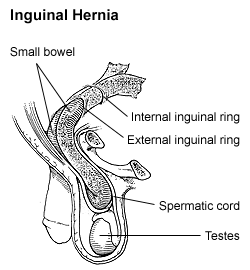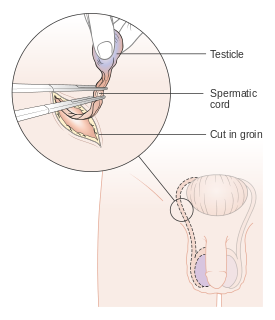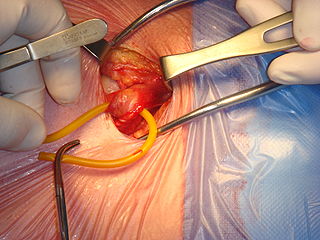This page is based on this
Wikipedia article Text is available under the
CC BY-SA 4.0 license; additional terms may apply.
Images, videos and audio are available under their respective licenses.

A hernia is the abnormal exit of tissue or an organ, such as the bowel, through the wall of the cavity in which it normally resides. Hernias come in a number of different types. Most commonly they involve the abdomen, specifically the groin. Groin hernias are most common of the inguinal type but may also be femoral. Other hernias include hiatus, incisional, and umbilical hernias. Symptoms are present in about 66% of people with groin hernias. This may include pain or discomfort especially with coughing, exercise, or going to the bathroom. Often it gets worse throughout the day and improves when lying down. A bulging area may occur that becomes larger when bearing down. Groin hernias occur more often on the right than left side. The main concern is strangulation, where the blood supply to part of the bowel is blocked. This usually produces severe pain and tenderness of the area. Hiatus or hiatal hernias often result in heartburn but may also cause chest pain or pain with eating.
Underpants are an undergarment covering the body from the waist or hips to the top of the thighs or knees. In British English the term refers to men's underwear, while in the US the term is gender neutral. The equivalent woman's garment are panties.

Tinea cruris is a dermatophyte, a type of fungal infection of the groin region in either sex, though more often seen in males.

An inguinal hernia is a protrusion of abdominal-cavity contents through the inguinal canal. Symptoms are present in about 66% of affected people. This may include pain or discomfort especially with coughing, exercise, or bowel movements. Often it gets worse throughout the day and improves when lying down. A bulging area may occur that becomes larger when bearing down. Inguinal hernias occur more often on the right than left side. The main concern is strangulation, where the blood supply to part of the intestine is blocked. This usually produces severe pain and tenderness of the area.

A groin vault or groined vault is produced by the intersection at right angles of two barrel vaults. The word "groin" refers to the edge between the intersecting vaults. Sometimes the arches of groin vaults are pointed instead of round. In comparison with a barrel vault, a groin vault provides good economies of material and labour. The thrust is concentrated along the groins or arrises, so the vault need only be abutted at its four corners.
Athletic pubalgia, also called sports hernia, hockey hernia, hockey groin, Gilmore's Groin, or groin disruption is a medical condition of the pubic joint affecting athletes.

The ilium is the uppermost and largest part of the hip bone, and appears in most vertebrates including mammals and birds, but not bony fish. All reptiles have an ilium except snakes, although some snake species have a tiny bone which is considered to be an ilium.
Central line or Central Line may refer to:
Dunsandle Castle is a 15th-century castle near Athenry, County Galway, in Ireland.
Dmitry Tursunov was the defending champion, however he chose to not participate this year. Michaël Llodra won in the final 7–5, 6–2 against Guillermo García-López.

Orchiectomy is a surgical procedure in which one or both testicles are removed. The removal of both testicles is the surgical form of castration.
Marcos Baghdatis was the defending champion after defeating Richard Gasquet in the 2010 final but had to withdraw from the tournament in 2011.
Gilles Simon won the championships by beating 4th seed Viktor Troicki 7–5, 7–6(4) in the final.

Inguinal hernia surgery is an operation to repair a weakness in the abdominal wall that abnormally allows abdominal contents to slip into a narrow tube called the inguinal canal in the groin region.
The 2011 BNP Paribas Masters – Singles was the main event of the 2011 BNP Paribas Masters men's tennis tournament played in Paris, France from 7 November through 13 November 2011.
Sara Errani and Roberta Vinci were the defending champions, but lost in the final to Ekaterina Makarova and Elena Vesnina 5–7, 2–6.
Rohan Bopanna and Colin Fleming were the defending champions, but Bopanna chose not to participate. Fleming played alongside Ross Hutchins, but lost in the quarterfinals to Marin Draganja and Mate Pavić.
Julien Benneteau and Édouard Roger-Vasselin won the title, defeating Paul Hanley and Jonathan Marray in the final, 4–6, 7–6(8–6), [13–11].
The 2014 Sony Open Tennis – Men's Singles was the main men's event of the 2014 Sony Open Tennis tennis tournament played in Key Biscane, USA from March 17 through March 30, 2014.
Stan Wawrinka was the defending champion, but chose not to participate this year.






